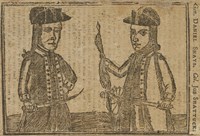- Field Trips (5)
- Lesson Plan (5)
- Distance Learning (1)
- Guest Speakers (1)
- Student Activities (1)
- Science (9)
- Social Studies (6)
- Literacy and Language Arts (3)
- Math (1)
Showing 13 results for touch ...
Plants Three-Touch Field Trip Model
- Type: Field Trips
- Grade Levels: Upper Elementary: Third Grade through Fifth Grade
There are over 1,500 different plant species found within Delaware Water Gap National Recreation Area. Most plants, even 100-foot tall hemlock trees, start out as small seeds. In this lesson, students will think like a botanists as they explore, observe, and discover how plants grow, how to identify different species, and how phenology is altered as result of climate change. Pre and post visit activities and supplementary materials.
Ecology Three-Touch Field Trip Model
- Type: Field Trips
- Grade Levels: Upper Elementary: Third Grade through Fifth Grade
Have you ever thought about how to power a person? We don't plug ourselves into an outlet on the wall, rather we get our energy from the food that we eat. This field trip focuses on the questions surrounding how energy is transferred throughout an ecosystem, how ecologists classify living things, and how living and non-living things interact. The field trip follows a three-touch model, where students complete activities in the classroom before and after a field trip.
See, Touch, and Hear: Preschool-age students
Tumacácori in Five Senses - PreK -1
- Type: Lesson Plan
- Grade Levels: Upper Elementary: Third Grade through Fifth Grade
Students observe trees through touch, smell, and finally through sight with this interactive lesson plan.
What's That Green Stuff In The Cave?
Dots, Dashes and Deliveries: 5th - 6th grade
- Type: Guest Speakers
- Grade Levels: Middle School: Sixth Grade through Eighth Grade
Communication on the American Frontier was challenging to say the least. From freight services to the short-lived Pony Express and the telegraph, students will learn about the various ways people living in the American West sent messages and letters to stay in touch with family and friends back East.
- Type: Lesson Plan
- Grade Levels: Upper Elementary: Third Grade through Fifth Grade
A three-touch model field trip where students will investigate the reasons that Springfield Massachusetts was selected for the nation’s first armory. Students will create their own maps and explore primary sources to learn about what this area would have looked like in 1777 prior to the founding of the armory.
River Ramble
- Type: Field Trips
- Grade Levels: Upper Elementary: Third Grade through Fifth Grade
This exploratory walk highlights the ecology of the Santa Cruz River Valley. This program will also touch upon the importance of river corridors as locations for traditional O’odham villages. Students will learn about the plants that were used for clothing, tools, and food. Learning will involve inquiry, sensory activities, and language arts.
Shays’ Rebellion: A Nation on Trial
- Type: Lesson Plan
- Grade Levels: Middle School: Sixth Grade through Eighth Grade
A three-touch model field trip where students will investigate the events that led to Shays’ Rebellion. Students will role play as historical figures and determine who was at fault for the conflict with a post-visit activity where students will explore the deeper implications of assigning blame and the continuing role of protest in society today.
Senses Songs
Prairie Animals and Habitats
- Type: Distance Learning
- Grade Levels: Lower Elementary: Pre-Kindergarten through Second Grade
Badlands National Park protects 244,000 acres of mixed-grass prairie habitat and the wild animals that live in it. Prairie vegetation is mostly grasses--find out why. Then take a look at some of the wildlife (including bison, pronghorn, prairie dogs, and black-footed ferrets) that have adaptations that allow them to thrive in the prairie environment. Students participating in the in-class program may see and touch animal pelts, complete a puzzle, or complete a craft.
- Type: Lesson Plan
- Grade Levels: Middle School: Sixth Grade through Eighth Grade












